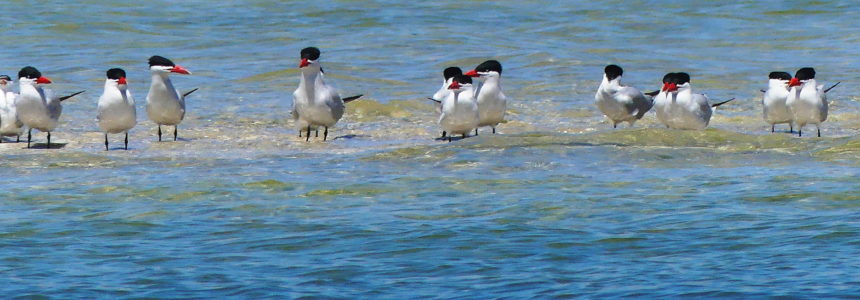News & Updates
Port Tampa Bay & Partners Increase Critical Nesting Habitat for Protected Birds

A historic dredging project has created new opportunities for Port Tampa Bay and its environmental partners to protect shoreline birds in Hillsborough Bay.
Every year, thousands of protected and rare birds flock to port-owned bird sanctuaries: two 500-acre “spoil” islands created by dredge materials from harbor management operations. The spoil islands serve as a substitute home for shoreline birds displaced from coastal beaches because of human activity.
Port Tampa Bay, Audubon Florida, the U.S. Army Corps of Engineers, the Florida Fish and Wildlife Conservation Commission, and the U.S. Fish and Wildlife Commission work to protect thousands of birds that nest on these dredge disposal islands.
This year, dredge work at the Big Bend Channel created approximately 100 acres of enhanced habitat including sandy beach which will provide new attractive nesting and roosting areas.
“In our long-standing commitment to the environment, we have strived to be a leader in best practices and policy,” said Port Tampa Bay President/CEO Paul Anderson. “We will do everything we can to engage our key partners to protect our local wildlife.”
The Big Bend Channel expansion construction began last October and finished earlier this month. Environmental engineers unloaded 3.4 million cubic yards of dredged materials to create large flat sand/shell expanses and adjacent interior shoreline that will enhance the protected nesting habitat for generations to come.
“It created a bird paradise, “said U.S. Army Corps of Engineers Spokesman Andy Cummings.
The spoil islands, called “2D” and 3D”, located in Hillsborough Bay just south of MacDill Air Force Base are designated “no trespassing” areas. The Big Bend Channel Expansion project created new nesting opportunities for many species of rare birds that frequent the dredge disposal island “3D”.
“I have never seen so much viable nesting produced in one dredging job,” said Lorraine Margeson, a bird monitor and subcontractor for the Army Corps of Engineers. “3D is home to one of the biggest mixed colonial nesting islands in the state.”

Depositing dredge material on the islands both makes the shipping channels safe for the passage of large ships and also creates a prime nesting habitat for terns, skimmers, oystercatchers, and gulls. Thousands of birds nest successfully inside the 40-foot dike, which protects them from viewing and impact from the public.
“The birds choose these deposition sites as a good spot to lay their eggs and raise their chicks, especially as the islands are protected from disturbance and surrounded by the bait-fish rich waters of Tampa Bay” said Audubon Sanctuary Manager Mark Rachal.
Birds that nest in these areas are protected under the Migratory Bird Treaty Act of 1918, as well as the Florida Threatened and Endangered Species Act of 1977.
The annual bird nesting season begins April 1 and runs through August 31.
About Port Tampa Bay
Port Tampa Bay is Florida’s largest port and the largest economic engine in west central Florida, supporting nearly 85,000 jobs and generating over $18 billion in annual economic impact. In addition to being a top 10 U.S. cruise port, the port handles a wide array of bulk, break bulk, containers and roll-on/roll-off cargoes, and is a major shipbuilding and repair center. For more information, visit www.portTB.com.
###
Contact:
Samara Sodos, Director of Public Relations
Port Tampa Bay
Cell: 813-468-9882
ssodos@tampaport.com
